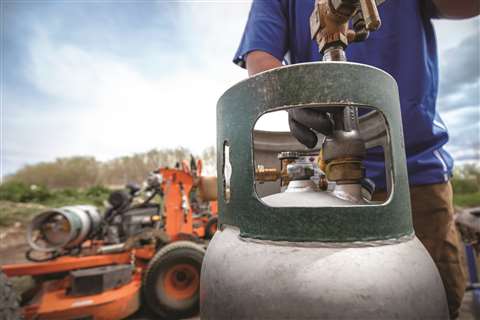Propane rides the ebbs & flows of mower market
02 December 2022
 As gasoline and diesel prices climb, propane market share, particularly in landscaping, tends to increase with them. (Photo: Propane & Education Research Council)
As gasoline and diesel prices climb, propane market share, particularly in landscaping, tends to increase with them. (Photo: Propane & Education Research Council)
There was a time when nearly every major commercial mower manufacturer had a dedicated propane-powered mower option. As of early 2020, estimates showed more than 150 models produced by 14 manufacturers in a variety of configurations, from walk-behinds up to zero-turn.
Then, came the pandemic, with its lockdowns, workforce shortages and extended supply chain disruptions. With OEMs struggling to find both people and parts to produce their bread-and-butter products, propane-only mowers – which are also highly subject to the ebbs and flows of fuel pricing – quietly faded from product lineups.
“As gasoline prices cheapened… we lost all of those OEM manufacturers [producing propane-only models] right out of the factories, and now they’re just making the gasoline version,” said Mike Newland, director of agriculture business development, Propane Education & Research Council (PERC), who also oversees commercial mowing. “We’re down to conversions… but they’re very effective conversions.”
A handful of companies offer EPA-certified conversion kits for gasoline mowers, each designed for a specific engine. Kit suppliers work directly with the engine manufacturers to ensure compatibility and ease of application.
“We have kits available, I would say, for every major engine manufacturer that’s in this space,” Newland said, noting, “A lot of the big OEMs are very supportive of the conversions.”
The kits enable easy, lower cost (~$1,000) adoption of propane by customers without the need for OEMs to produce a propane-only mower for what has been a select customer base. In 2020, PERC estimated roughly 20,000 propane-powered commercial mowers were in operation across the U.S., representing about 5% of the total mower market. While a substantial uptick from the prior decade, it still qualifies as a niche segment, and it’s unclear what affect the pandemic had on this figure and the trajectory of growth.
Interest increases with fuel costs
Despite what may seem a rather tenuous foothold, Newland said there is upside potential for propane in the commercial mower market.
“What we’ve seen with propane, and commercial mowing especially, is kind of an ebb and flow through history,” he said. “Gasoline prices and diesel prices have really driven adoption if you look back and track those historical prices. So, when we see the price of diesel and gasoline climb, we see propane market share respond and increase right along with it.”
But Newland said propane is currently in a “unique spot” given the state of the crude oil market. “We track propane prices versus crude oil and there’s always a nice relationship between those two commodities. That spread has gone a little bit out of kilter over the last four to six months, and it’s in favor of propane. The price advantage that we always historically see over gasoline and diesel fuel has widened considerably.
“[Propane] is in a very advantageous position versus its competitors right now, so it’s getting a lot of attention.”
This attention could expand further as the colder months progress. Geopolitical factors – particularly the war in the Ukraine – have caused price estimates for traditional heating fuels to skyrocket. In fact, as of mid-October, the U.S. Energy Information Administration was forecasting U.S. households to spend 28% more for natural gas, 27% more for heating oil and 10% more for electricity this winter, yet only 5% more for propane.
“We’re seeing some pretty big numbers potentially coming out of the Northeast, especially on diesel and heating fuel this winter, and we are internally keeping an eye on it,” Newland said. “We think our fuel could be at a bigger price advantage in the coming months than it is currently.”
 Environmental concerns are helping to drive adoption of propane fuel. (Photo: Propane & Education Research Council)
Environmental concerns are helping to drive adoption of propane fuel. (Photo: Propane & Education Research Council)
Cleaner is better
Interest in propane among landscapers and turf management companies isn’t driven by cost alone. Also driving not just interest but adoption of propane fuel is concern about the environment – led as much or more by their customers as by the companies themselves.
“We’re seeing more and more contracts being issued to cutters that have an environmentally friendly fuel source. The contracts and bids are specifying that they’d like to see clean alternative fuels being used,” Newland said. “A number of cutters that are using propane in their commercial mowing fleets are winning contracts as a result of having that clean fuel and being able to tout that in their bid process.”
Yet, ironically, when it comes time to talk clean air solutions, propane isn’t always included in the conversation. “[Propane is] a great fuel that unfortunately some regulators in some states aren’t giving a lot of credence to,” said Newland. “I believe that we are part of a very real solution to clean air. Any time that propane is involved, we are part of that solution.”
Substantial emphasis has instead been placed in some states on electrification, with many commercial mower manufacturers now offering electric models. But there are arguments that favor propane as the cleaner choice.
“The power that propane provides for the entire day without any recharging or any downtime, we think is a huge benefit,” Newland commented. “But we also look at the total life cycle of generating that electricity from start to finish. We’ve done in-depth studies looking at total life cycle emissions and comparing propane to other energy sources, such as electric… and if you consider the source energy for electric production and the inefficiencies of the current electric grid, propane mowers are simply cleaner as far as cleanliness and environmental impact.”
As such, PERC is working to pull propane back into the clean air conversation. “We get into a clean air discussion, we’re in great shape, because we think [propane] will compete incredibly well against EVs because we take into account where the power that’s turning that EV, that electric motor, is coming from. Electric isn’t clean coming out of the wall. Most U.S. grid electricity is produced by burning natural gas or coal. If the demand for electricity increases, the rate at which natural gas and coal is burned also rises. The result – more greenhouse gases polluting the air in communities where electricity is generated. You have to take into account how it’s made, where it’s made and the transmission loss in getting it from that power plant to that electrical outlet,” said Newland.
“In many states, [propane] is cleaner than the electric grid. So, we’ve got a great story to tell.”
To learn more about propane use in the landscape and turf management industry, as well as propane conversion kits, visit www.propane.com.
STAY CONNECTED




Receive the information you need when you need it through our world-leading magazines, newsletters and daily briefings.
POWER SOURCING GUIDE
The trusted reference and buyer’s guide for 83 years
The original “desktop search engine,” guiding nearly 10,000 users in more than 90 countries it is the primary reference for specifications and details on all the components that go into engine systems.
Visit Now
CONNECT WITH THE TEAM










